The ROG Zephyrus G is Asus’s lineup of ultraportable gaming notebooks based on AMD hardware. It made its debut last year with the 15-inch Zephyrus GA502.
This year, Asus not only updated the 15-inch variant with newer hardware and higher-refresh screens, but also launched a more compact, and in many ways more interesting Zephyrus G14 GA401 14-inch variant with AMD processors, up to 32 GB of RAM and RTX 2060 graphics.
We’ve spent a few hours with a pre-production version of this notebook and some of the Asus reps in charge with developing the project, and gathered our thoughts from this meeting in the article below. It’s a detailed first look at the Asus ROG Zephyrus G14, the most powerful 14-inch gaming notebook of the moment.
The laptop is not just about the specs, thermals and the fast refresh-screen you’d expect from a modern gaming notebook, all unmatched by other 14-inch or smaller products at this point, but also about a lightweight and durable magnesium design, quad-speakers, a big battery with dual-charging methods and fast wireless. It also no longer compromises as much as the 2019 Zephyrus G15, and we’ll explain what that means down below.
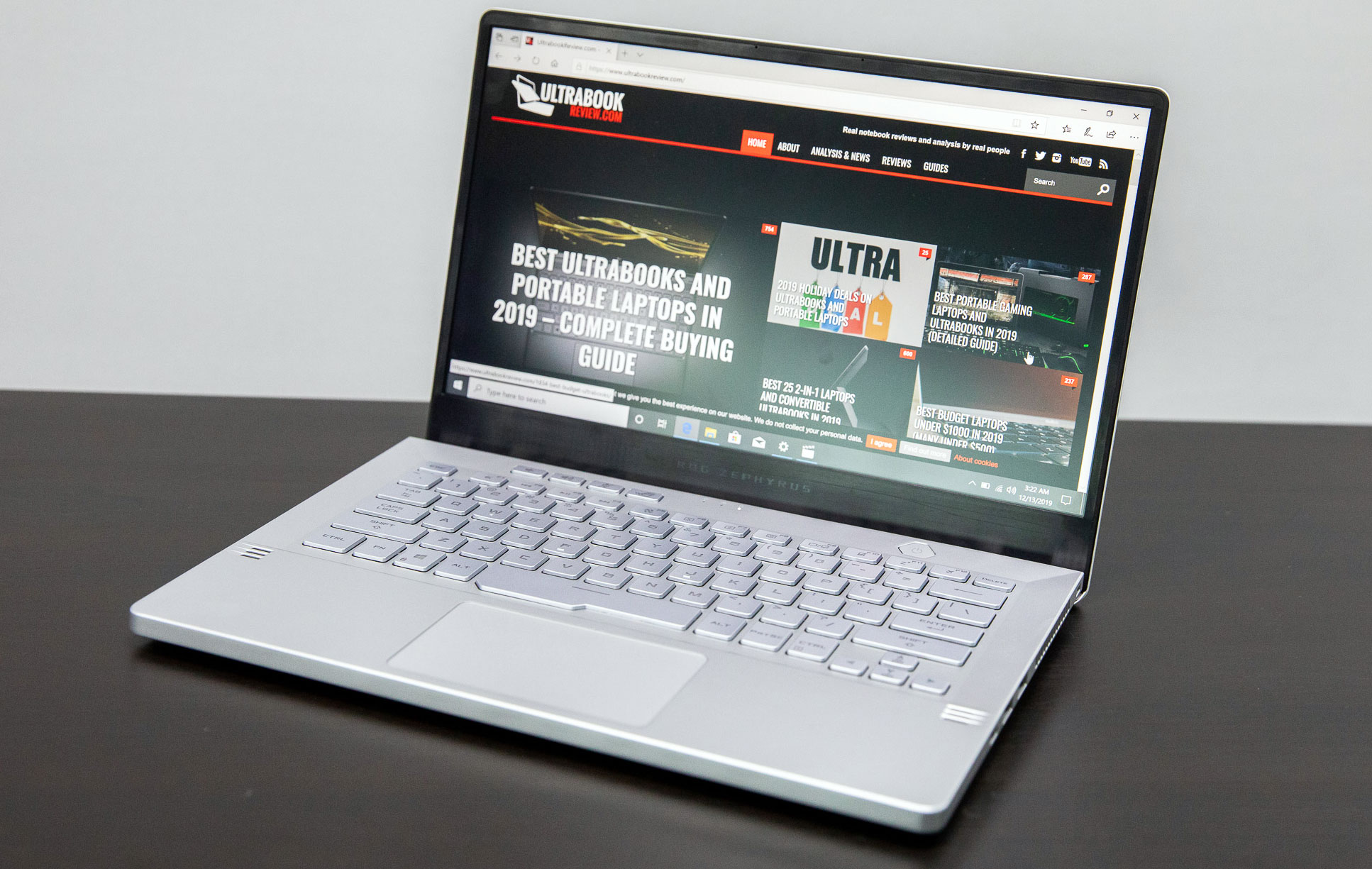
14-inch Asus Zephyrus G14 gaming ultraportable with AMD Ryzen 4000 and RTX 2060 graphics
But first, here’s a quick specs sheet of the 2020 ROG Zephyrus G14 GA401I, right next to the updated 2020 Zephyrus G15 GA502I, for comparison.
| Asus ROG Zephyrus G14 GA401I | Asus ROG Zephyrus G15 GA502I | |
| Screen | 14 inch, FHD 1920 x 1080 px resolution, IPS-Level, 60 Hz, matte, 100% sRGB, Pantone Validated 14 inch, FHD 1920 x 1080 px resolution, IPS-Level, 120 Hz, matte, 100% sRGB, Pantone Validated 14 inch, WQHD 2560 x 1440 px resolution, IPS-Level, 60 Hz, matte, 100% sRGB, Pantone Validated |
15.6 inch, FHD 1920 x 1080 px resolution, IPS-Level, 240 Hz 3ms, matte, 100% sRGB, Pantone Validated 15.6 inch, FHD 1920 x 1080 px resolution, IPS-Level, 144 Hz, matte, 72% sRGB |
| Processor | AMD Ryzen-H 4000, up to Ryzen 7 4800HS 35W (8C, 16T) | AMD Ryzen-H 4000, up to Ryzen 7 4800HS 35W (8C, 16T) |
| Video | Radeon RX and Nvidia GeForce RTX 2060 6GB (65W) | Radeon RX and Nvidia GeForce GTX 1660Ti 6GB (60W) or RTX 2060 6GB (65W) |
| Memory | up to 32 GB DDR4 3200 MHz (16 GB soldered, 1x DIMM) | up to 32 GB DDR4 3200 MHz (16 GB soldered, 1x DIMM) |
| Storage | 1x M.2 PCIe 2280 and 2230 formats (TBU) | 2x M.2 PCIe 2280 formats |
| Connectivity | WiFi 6 AX 2.2 with Bluetooth 5.0 | WiFi 6 AX 2.2 with Bluetooth 5.0 |
| Ports | 2x USB-A 3.2, 2x USB-C gen 2 with DP and charging, HDMI 2.0b, headphone/mic, Kensington Lock | 3x USB-A 3.2, 1x USB-C gen 2 with DP, HDMI 2.0b, LAN, headphone/mic, Kensington Lock |
| Battery | 76 Wh, 180 W power adapter (more compact than on previous Zephyrus G GA502), also charges via USB-C | 76 Wh, 180 W power adapter (more compact than on previous Zephyrus G GA502), also charges via USB-C |
| Size | 324 mm or 12.75” (w) x 222 mm or 8.74” (d) x 17.9 mm or .7” (h) | 360 mm or 14.17” (w) x 252 mm or 9.92” (d) x 19.9 mm or .78” (h) |
| Weight | ~1.6 kg (3.53 lb) | ~2.1 kg (4.6 lb) |
| Extras | white backlit keyboard, quad speakers, Optional Matrix LED lid panel, no webcam, available in Space Gray or Mirage White | white backlit keyboard, stereo bottom speakers, no webcam |
Design and daily use experience
The Zephyrus G14 is a completely new design and not based on the existing Zephyrus G 15 chassis, unlike the 2020 GA502I, which is mostly a hardware refresh of the previous GA502DU generation.
With a 14-inch screen and fairly compact form-factor, it’s designed to be more portable than the existing 15-inch gaming notebooks, but without sacrificing on usability and performance.
Magnesium-aluminum alloys are used for the main chassis, with a premium feel and the same fingerprint resistance shown by the higher-tier Zephyrus M and S lineups. The bottom is still plastic, and the top is made out of aluminum.
Asus offers a choice of either darker (Space Gray) or lighter (Mirage White) colors. I would normally lean towards the White model, it looks neat and the White lid does a better job at hiding smudges, but then this also gets a Silver keyboard, and white-backlit silver keys are a pain to deal with due to their poor contrast. Hence, the Space Gray would be my choice between the two.
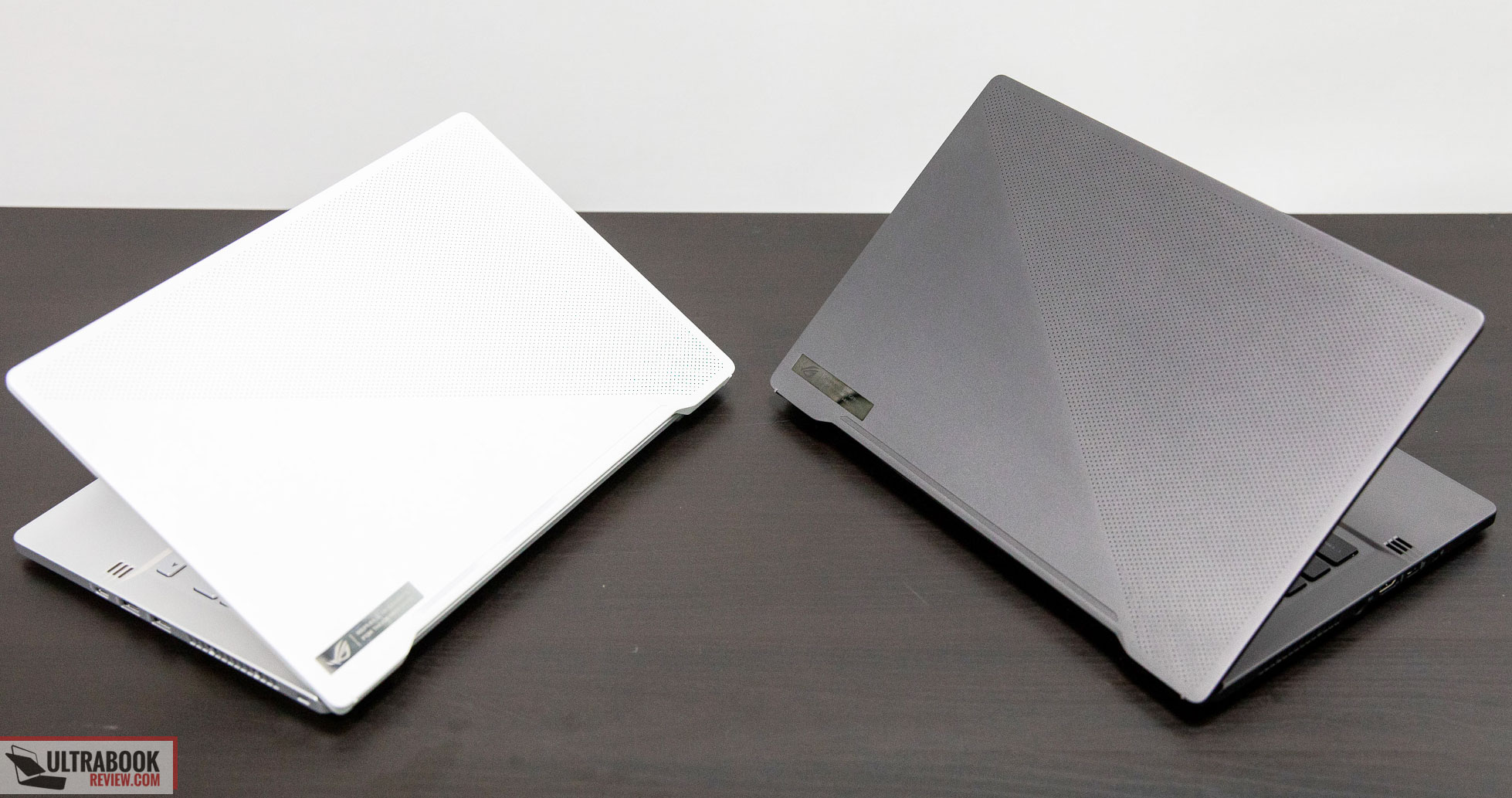
Let’s get back on that lid for a bit. You might have noticed there are many many tiny holes in it, and they’re not just for aesthetics. Asus plans to offer the G14 with two types of lids, one of them including an extra array of customizable LEDs pushing light through those tiny holes, called an AnimeMatrix display. This can be used to display various information, from static content to animations, all customizable in an included app. There are more than 6000 thousand holes in the lid, as well as 1200+ LEDs in the matrix array, each in charge of evenly illuminating 4 holes with the help of a diffusion layer.
The whole design process behind this technology was complex, the matrix including the layer of LEDs, the diffusion layer and a protection film to prevent dust and dirt from getting inside, and engineers having to evenly spread the lighting across the entire array, while accounting for thermal and power constraints.
I haven’t yet seen a working version of this screen, it was not functioning in the preview samples I’ve been presented. Thus, I can’t tell if it’s actually useful in real life and worth paying the extra for. I appreciate Asus trying to make their products stand-out and offer a degree of personalization, but I’m also a big fan of simple basic designs, that’s why I was happy to hear that Asus won’t force this on you and will offer the Zephyrus G14 in versions with or without the AnimeMatrix display.
It’s also worth mentioning that the LED Matrix is especially visible on the Space Gray variant and I don’t think will be included with the White model.
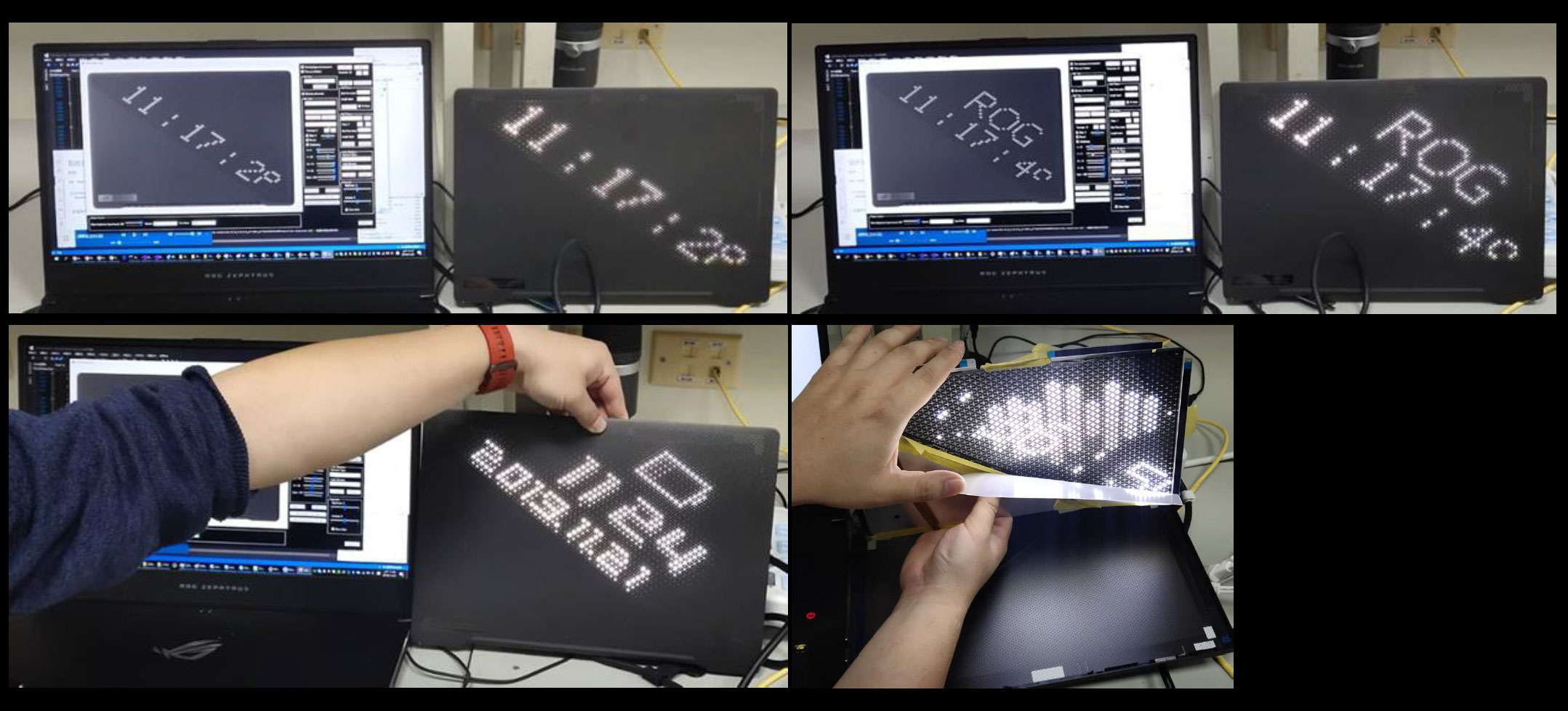
A preview of the AreaMatrix LED display
Back to the basics, the Zephyrus G14 gets ar Ergolift hinge design which pushes up the main-chassis on rubber feet at the bottom of the screen, in order to improve airflow underneath and help cool the components. Ergolift designs have one major flaw, though, and that’s the fact that hot air is blown into the screen. It’s an issue here as well, but not as bad as on ZenBooks.
For starters, there’s a bigger gap between the exhausts and the screen than on most ZenBooks. Then, the lid design also allows some of the hot air to go out to the back, through that carving in the bottom side. Finally, the ROG engineers smartly designed the radiators and plastic fins that split the hot air coming out from the exhausts, sending some of it downwards and some of it upwards and to the sides, so not straight into the screen. I haven’t got to test this implementation in games and measure the panel-temperatures around the exhausts, so I can’t vouch for the practical worth of this solution, but it shows they were aware of the problem and did something to at least partially address it. We’ll further touch on the thermal design in the next section.
In the meantime, I’ll also mention a couple of other aspects you should be aware of. First off, this notebook gets quad-speakers, with a set on main speakers (woofers, kind of) still firing on the bottom, but also a set of tweeters firing through those grills in the palm-rest. Not sure if that’s the best placement, as I fear they might be fairly easily cover by your palms with daily use, but again, they tried to address an issue of most modern gaming notebooks, within the space constraints of a 14-inch chassis.
Then, you’ll notice there’s no webcam on the Zephyrus G14, just like on the 15-inch model and many of the other recent ROG gaming laptops. I don’t mind it, but some of you might feel otherwise. I was told an external camera will not be included with the standard bundle, unlike on some of the Zephyrus S models; makes sense to help keep prices down.
There’s also a fingerprint sensor integrated into the power button of the G14, a first for an ROG laptop. It’s been touted for months and I’m glad to finally see it implemented. The redesigned button also ditches that pesky always-on light implemented with other ROG notebooks, but the status LEDs are still placed beneath the screen, annoying when trying to watch a movie at night. Please send them to the side or the front somewhere.
Finally, as far as the IO goes, the Zephyrus G14 offers a fair selection of ports, with USB-A and C ports, HDMI and an audio jack. There’s no LAN, but you get a USB to LAN adapter included for the rare occasions you’ll need wired Internet. There’s also no card-reader and no Thunderbolt 3, no surprise given this is an AMD-based notebook, but the left USB-C port allows charging. More on that further down.
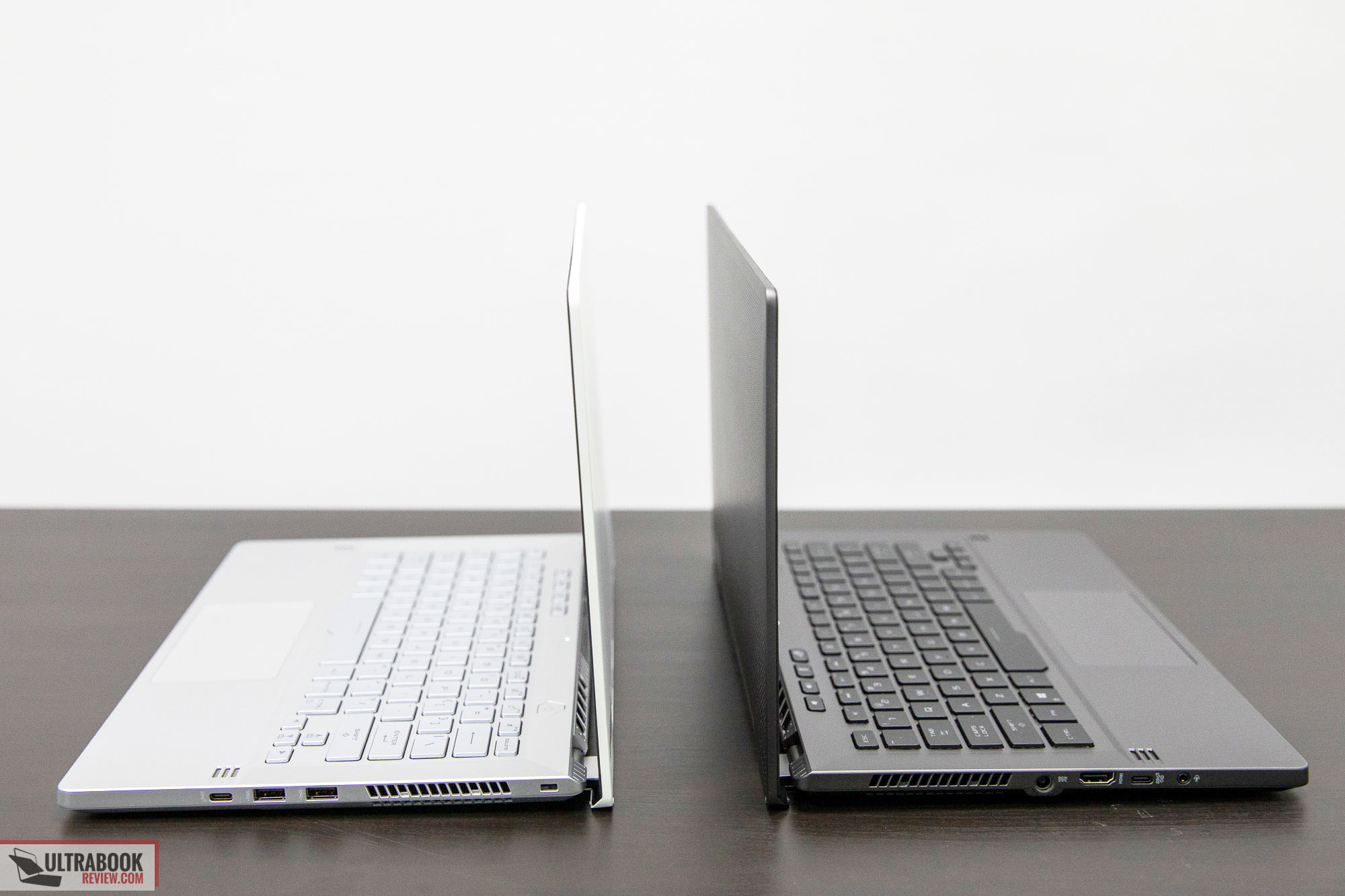
Typing experience and display options
I haven’t spent much time typing on the G14, but its keyboard felt much like the one on the larger G15, which was OK to type on, but also a bit shallow even for my liking.
The layout also resembles what Asus implement on the 15-inch version, with the extra multimedia keys at the top and the small, spaced out arrows, but without the extra Function column at the right. It’s a fine design.
The keys are backlit, with white LEDs, so RGB remains reserved for the higher-tier ROG laptops. I don’t mind it, but I still hate the poor contrast of white backlighting on silver keys, that’s why I prefer the black keyboard on the Space Gray version of the G14.
Finally, for mouse Asus went with a pretty basic approach, a plastic clickpad with Precision drivers and fairly quiet clicks.
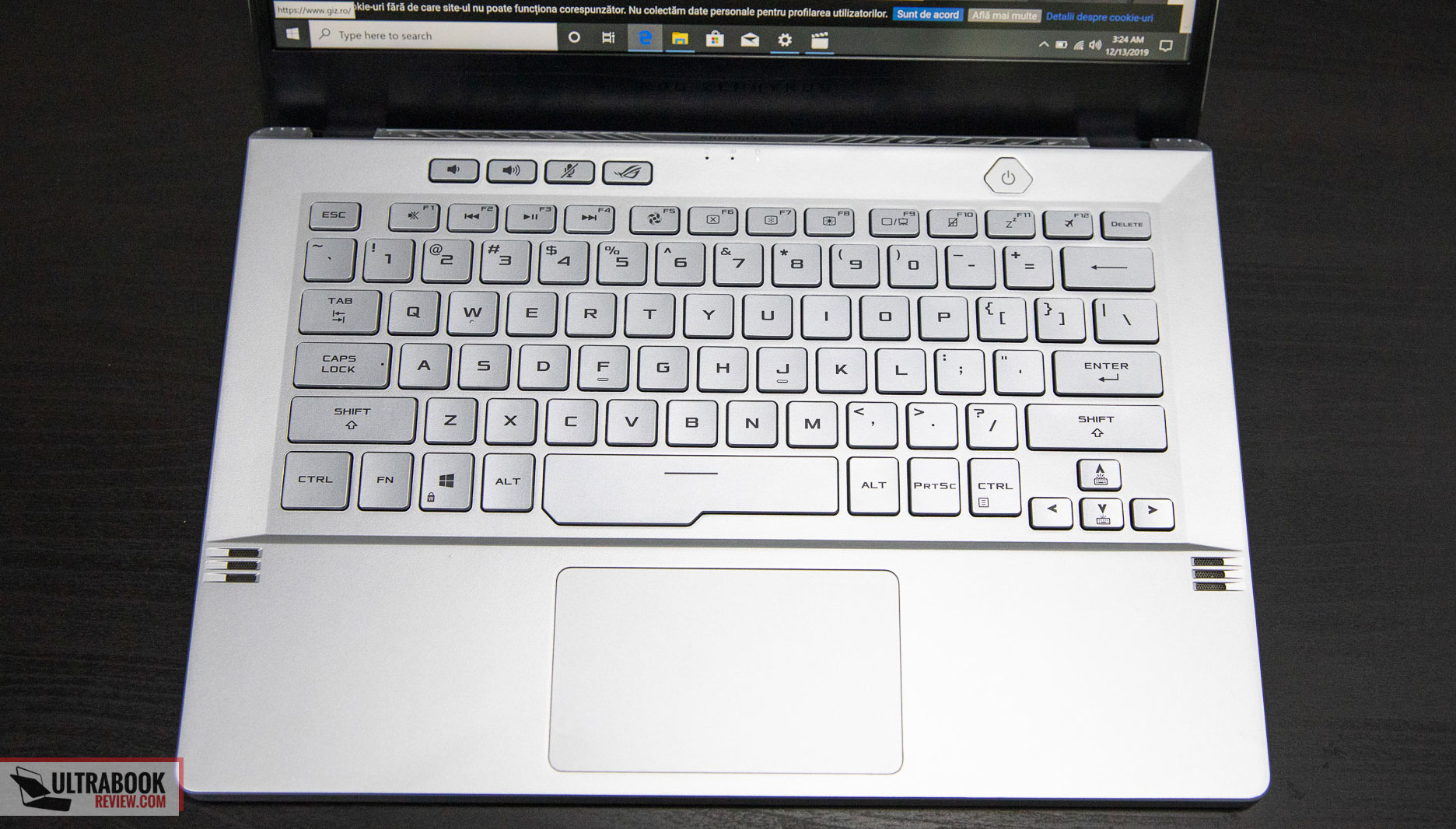
As far as the screen options go, there are three of them to choose from:
- 14 inch, FHD 1920 x 1080 px resolution, IPS-Level, 60 Hz, matte, 100% sRGB, Pantone Validated
- 14 inch, FHD 1920 x 1080 px resolution, IPS-Level, 120 Hz, matte, 100% sRGB, Pantone Validated
- 14 inch, WQHD 2560 x 1440 px resolution, IPS-Level, 60 Hz, matte, 100% sRGB, Pantone Validated
If you’re looking at this laptop for its gaming potential, the 120 Hz panel is the obvious choice. Yes, it’s not as fast as you can get with current 15-inch models, but it’s still night and day better than the 60 Hz versions out there. The choice for sub-15-inch high-refresh screens is extremely limited, so appreciate what you get here, the G14 is the only sub-15 notebook with a faster than 60 Hz panel at the time of this post, early January 2020.
Hardware and thermals
The Zephyrus G14 GA401 is built on an AMD Ryzen 4000 Core H hardware platform, with support for DDR4 RAM and PCIe x2 storage. It also implements WiFi 6 (Gig+) wireless, Bluetooth and a 76 Wh battery.
For the CPUs, Asus went with the Ryzen 7 4800HS implementation, a power-optimized version of the Ryzen 7 4800H with a 35W TDP power budget and slightly lower clocks. It’s still an 8 Core, 16 Thread processor, so a major step-up from the existing Ryzen-H 3000 in the 2019 Zephyrus G, and even most of the existing Core i5 and i7 45W Intel options, especially in demanding loads.
From what I’ve been told, the 4800HS runs at the same speeds (2.9 GHz Base, 4.2 GHz Boost) and should offer the same performance as the 4800H, but in an a higher-binned and more efficient power package. We’ll have to give it a proper test to confirm this, but if that’s the case I expect this CPU to come at a cost premium over the standard 45W version.
The platform is new at the time, so we’ll update with benchmarks results and tests in the following weeks.
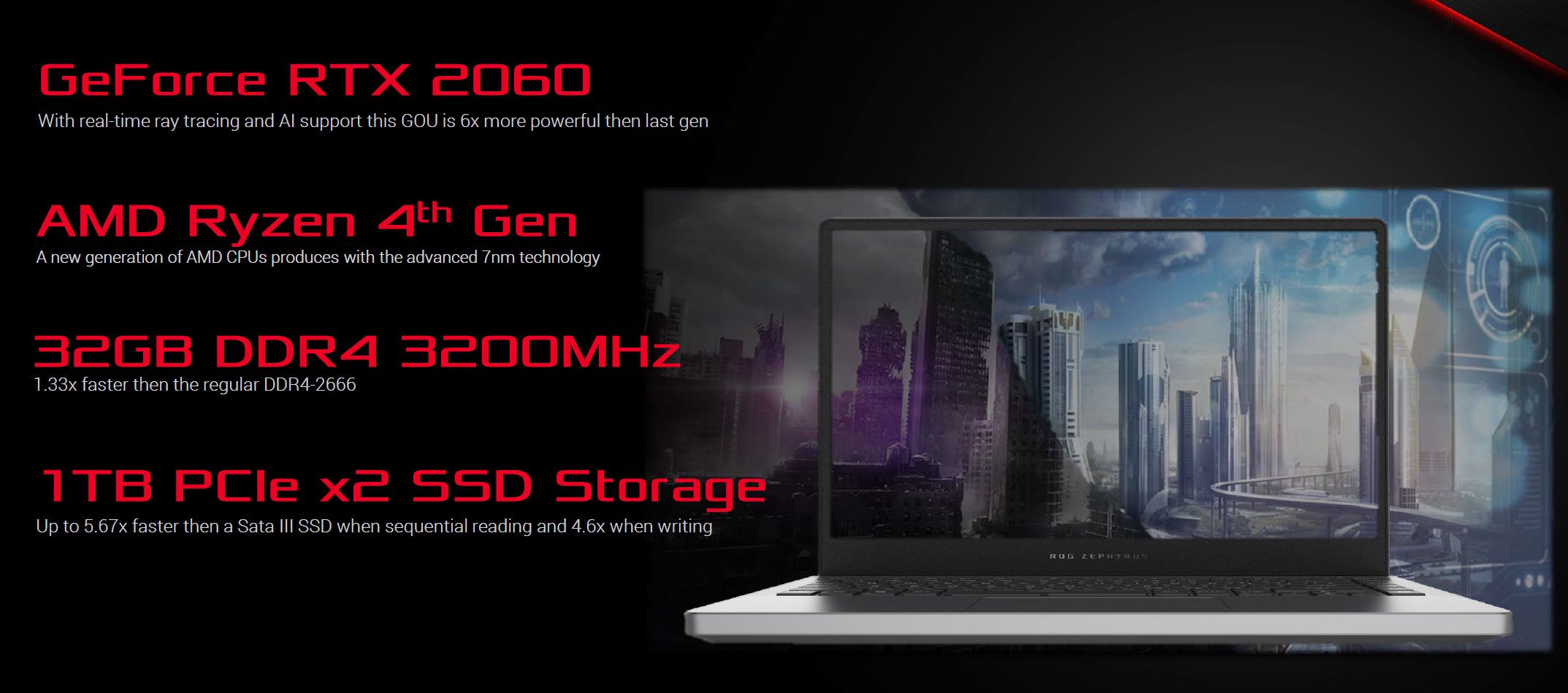
On the graphics side, Asus went with a power-optimized version of the RTX 2060 graphics chip from Nvidia, and not an all-AMD solution with either the Radeon RX 5500M or 5600M like on the Dell G5 15, in their quest to get the best performance within this envelope. That’s a 65W version of the RTX chip with lower clock speeds than the standard 80W RTX 2060, so expect a 10-20% associated drop in performance in tests, GPU loads and games. Expect the AMD hardware to also have an impact in games, knowing how many titles still favor Intel’s architectures, but the higher IPC and clocks should lead to a significant boost over the Ryzen-H 3000 models.
That aside, with the Zen2 AMD platform, the G14 gets support for faster DDR4 3200 MHz memory, and you can spec this up with up to 32 GB of RAM. 16 GB are soldered on the motherboard, and the rest goes in the available DIMM. Make sure to always have dual-channel on this laptop, the gaming performance is greatly influenced by this aspect with the modern Windows 10 versions. As far as I understand, the 16 GB binned by default work in single-channel, which means you will have to jump to 32 GB to get the full capabilities.
Finally, the G14 gets M.2 storage, limited to PCIe x2 from what we’ve been told. Peaking at the interior design, you’ll notice that Asus had to stack the wireless chip underneath the M.2 2280 SSD on this design.
You’ll also notice the complex thermal module, with two fans and an array of heatpipes spreading over the CPU, GPU and MOSFETs. It’s more complex than on the 2019 Zephyrus G15, but Asus might have also redesigned it for the 2020 15-inch update. In fact, it’s more complex than it might seem, on a first look.
Among the fine details, Asus went with 12v fans here with an uneven fin design, with some fins slightly shorter than others, in order to reduce turbulence and noise. The official literature mentions up to 45 dB in Turbo Mode, and for comparison, we measured up to 48-49 dB on the 2019 Zephyrus G15 with our tools. They also had to redesign smaller anti-dust channels in order to make room for this sort of fans in this 14-inch model.

Finally, the 14-inch Zephyrus G14 houses the same 76 Wh battery also included on the 15-inch Zephyrus G. It charges via a barrel plug charger, with 180W capacity in this configurations, and smaller/lighter construction than the 180W bricks previously implemented with 2019 ROG laptops.
The battery also charges via the USB-C port at up to 65W, and that allows you to leave the big charger at home and get a compact USB-C multi-purpose charger for both your phone and laptop when traveling, good enough to fill this up if you’re not playing games or running other intensive loads. There’s no USB-C charger included, so you’ll have to buy one on the side.

Some early thoughts
The Zephyrus G14 is for sure one of the most interesting small-format performance/gaming notebooks of the moment. It’s still bigger than heavier than the Razer Blade Stealth 13 or the MSI Prestige 14, but those only get Core U and GTX 1650 hardware, so definitely not in the same league.
It’s also a very clean and professional-looking computer that doesn’t compromise on build quality, unlike the previous Zephyrus G from 2019, so a good option for school, work and play at the end of the day, with the powerful specs and the 120 Hz screen that you won’t find in other sub-15-inch notebooks these days.
However, at the same time, 15-inchers like the Asus Zephyrus M or the MSI GS65 Stealth are only slightly bigger and heavier, but also more powerful, more refined and include a few features that the G14 lacks, such as RGB lit keyboards, 240 Hz screens and full-power GTX/RTX graphics.
As it is, the Zephyrus G14 GA401 has plenty to offer, but we’ll have to take it through a proper spin before we can draw conclusions on its performance, behavior, and overall worth. We also need to find out more about pricing, I’ve been told it’s going to be priced higher than the 2019 15-inch ZenBook G 15 at launch, which came at $1199. Too much higher and it would be getting too close to those 15-inch options, and I’m not sure its smaller footprint would be enough to steer you in its direction.






